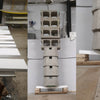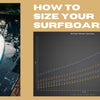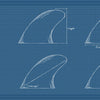Twin Fins Talk: The Ultimate Guide to Choosing Your Perfect Twin (part 1)

Where to start
Finding your perfect twin is a test and trial thing for sure, but as the offer is growing fast and there are so many options, you could miss the target many times before finding the perfect fit. Open your mind to new experiences and try twin fin in different options; taller, smaller, wider, or even get a +1… or +2. But first, it would be wise to try to understand them for what they are and how they work.
Learning to surf here in Montreal could be a challenge, we explore and search for new things and many times fail to score, but it ends up that we have the perfect playground to test many boards, fins, and gears, for a longer time, in similar conditions that remove a lot of the variables of the ocean. It also sculping our way of designing and thinking about surfboards. Twin fins have proved they work well in our experimental laboratory and most of our waves like upright fin profiles with a lot of surface area and you’ll understand why at the end of this serie.
I believe that no matter where you surf and which type of waves, you’re on, you’ll benefit from this (hopefully simple but complete) guide to selecting your twin fin for your surfboard.
Did you know that fins for your surfboard could be responsible for about half of the feeling you have under your feet?
The fins play a huge role in the ability to control your direction, speed, and stability on the waves. One of the most popular types of fins is the twin fin, which consists of two fins on either side of the tail. Twin-fin surfboards are generally fast, agile, and they can handle different kinds of waves. But how do you know which twin fin is best for your surfboard?
In this serie, we will guide you through the process of selecting the perfect twin fins for your surfboard, based on your weight, surfboard shape and size, skill level, wave conditions, and personal preference. We will also cover the differences and uses of Twin-fin, Twin+1, and Keel fins, as well as how the surface area, height, base width, rake, materials, foil, and cant of the fins affect your surfing performance and feel.
So let’s dive in!
Hold, Release, Drive, and Pivot

Before we start explaining the different aspects of a fin, let’s review some basic concepts that are essential for understanding how fins work. Hold, Release, Drive, and Pivot are terms that describe the performance and feel of your surfboard fins. Hold is the ability of your fins to keep your board stable and prevent it from sliding sideways while Release would be the opposite. The Drive is the ability of your fins to generate speed and power through turns. Pivot is the ability of your fins to turn quickly and sharply. The opposite of pivot would be Tracking (going straight down the line). In general, you want to balance these elements according to your own style and preference.
When choosing a twin fin for your surfboard, you need to consider the different aspects of a fin and how they affect your surfing performance and feel. The main aspects of a fin are; Area, Height, Base Length, Rake, Material, Foil, and Cant. Each of these aspects influences the Hold, Drive and Pivot ability of your board.
Twin, Twin+1, and Keel

Twin fins, twin+1, and keel fins are three types of fin setups that are used on different kinds of surfboards and for different purposes. Twin fins are two fins that are usually deeper and narrower than keel fins. They can be placed at various distances from the tail and have different cant and toe angles. They provide speed, maneuverability, and versatility for different waves and skill levels. They are fast, pivot and have good release. Twin+1 is a variation of twin fins that adds a small center fin or trailer to increase stability, drive, and control. They are often used on hybrid or performance boards that need more hold and drive. They tend to be a little bit slower than the twin and deliver a feel closer to the thruster (3fins setup). Keel fins are two large fins with long bases and short depths. They are usually placed closer to the tail and have minimal or zero can’t. They provide speed, stability, and drive for classic fish or Mini Simmons boards that have wide and thick tails. They tend to track, go down the line at full speed, and release well.
Now that we set all variables, in the next paragraph, we will explain what each aspect of fins means and how it affects your twin-fin surfing experience.
Next

In the next Blog, we will start to talk about the fins themself and we will cover the surface area, which is in my opinion one of the most important characteristics to look at when selecting your fin. There will be included, an analysis of 60 twin fins options for your surfboard and how to know which one is good for you and your board.
Hope you'll enjoy!
Cheers!




